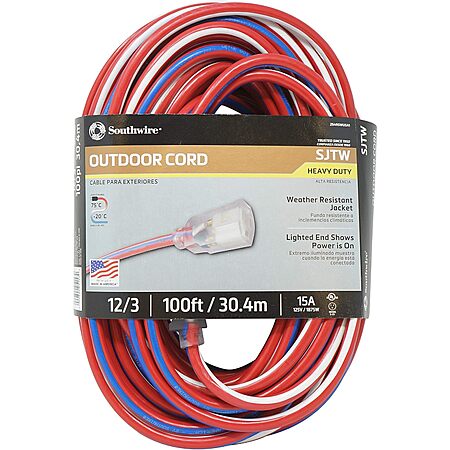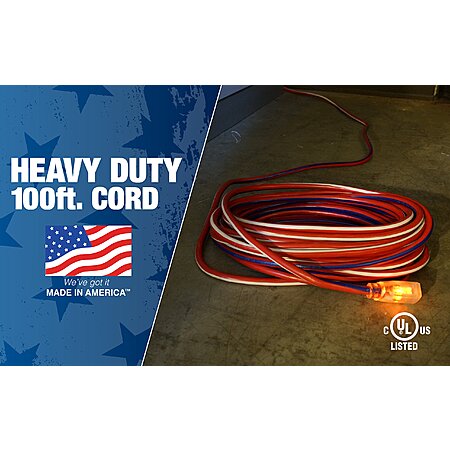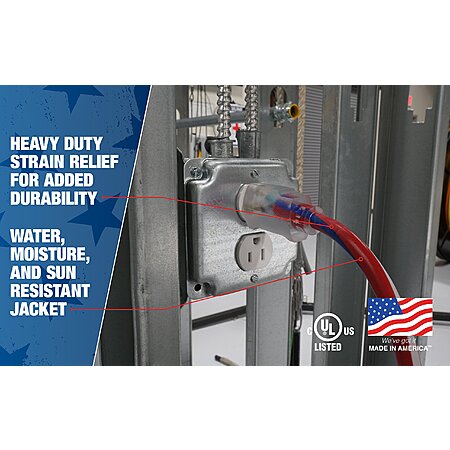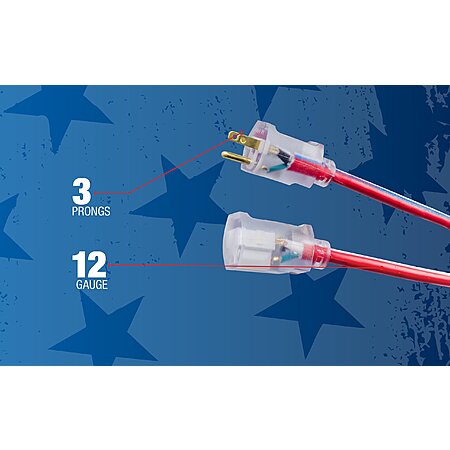expiredgaamn114 | Staff posted Mar 19, 2025 08:51 AM
Item 1 of 5
Item 1 of 5
expiredgaamn114 | Staff posted Mar 19, 2025 08:51 AM
100' Southwire 12/3 SJTW Heavy Duty Extension Cord w/ Lighted End
+ Free Shipping$53
$86
38% offAmazon
Visit AmazonGood Deal
Bad Deal
Save
Share








Leave a Comment
Top Comments
People have left my "repaired" cords alone. Even found one sitting in a parking lot after it fell off my truck.
The longer the cord, the lower the peak.
64 Comments
Sign up for a Slickdeals account to remove this ad.
The only way to know for sure is to plug the speaker into a Kill A Watt type device, crank it up, and see what the max power consumption is in reality.
In any event, this extension cord should easily be able to handle the power draw of his speaker (even if it's 3-4A), and a 16 gauge should be enough as well.
Normally, 14 awg wire is capable of 15 amps and 12 awg is capable of 20 amps.
It looks like the reason is continuous use vs peak:
12 AWG copper wire is suitable for a 20-amp circuit, and it's a common practice in residential wiring. However, for continuous loads exceeding 3 hours, it's recommended to limit the load to 80% of the breaker rating (16 amps). - Google AI
Normally, 14 awg wire is capable of 15 amps and 12 awg is capable of 20 amps.
It looks like the reason is continuous use vs peak:
12 AWG copper wire is suitable for a 20-amp circuit, and it's a common practice in residential wiring. However, for continuous loads exceeding 3 hours, it's recommended to limit the load to 80% of the breaker rating (16 amps). - Google AI
Normally, 14 awg wire is capable of 15 amps and 12 awg is capable of 20 amps.
It looks like the reason is continuous use vs peak:
12 AWG copper wire is suitable for a 20-amp circuit, and it's a common practice in residential wiring. However, for continuous loads exceeding 3 hours, it's recommended to limit the load to 80% of the breaker rating (16 amps). - Google AI
The longer the cord, the lower the peak.
Our community has rated this post as helpful. If you agree, why not thank BrentB3660
Also, is it "Made in America"?
Notice the packaging and cord say:
"We've got it
MADE IN AMERICA tm"
This is a trademark slogan... I'm willing to bet it's NOT made in America.
Deceptive how the "made in america" is bold also....
Also, the proper labeling is "Made in USA", so this is not that... so likely made in elsewhere (China?)
According to the Federal Trade Commission, "Made in USA" means that "all or virtually all" the product has been made in America. That is, all significant parts, processing and labor that go into the product must be of U.S. origin
I'm sure it's a fine 12/3 cord, just don't expect too much.
My $.02
Sign up for a Slickdeals account to remove this ad.
Our community has rated this post as helpful. If you agree, why not thank Nothingworked
People have left my "repaired" cords alone. Even found one sitting in a parking lot after it fell off my truck.
Yes, these are made in the US (manufacturer's website).
Yes, they are solid copper (manufacturer's response to a customer on homedepot.com).
Yes, these are heavier than a lower rated cable, but it is 12lbs.
I only keep 12ga extension cords in my garage because I don't want to worry about finding the "right one" to safely run my equipment.
My understanding, for example, was that a 25' cord was rated to be used by itself only... and that same 25' section is not designed or intended to be part of a longer length and could potentially be bad as it wasn't made to be carrying a current at that length.
But like I said, someone with more knowledge should probably say for sure...?
My understanding, for example, was that a 25' cord was rated to be used by itself only... and that same 25' section is not designed or intended to be part of a longer length and could potentially be bad as it wasn't made to be carrying a current at that length.
But like I said, someone with more knowledge should probably say for sure...?
Ideally a single cord is better, but for most, two 50 foot will meet the same needs as a single 100 foot.
Even better is have one 10/3 50 foot and one 12/3 100 foot.
The 50 foot will power most any household item continuously with no issues, and if you need more distance, you have the 100 foot. If you need even more, use the 50 foot from the outlet, then add the 100 foot to that.
I got this cord for my neighbor (widowed older lady), I have a generator that gives me more than enough power, so I put this through the fence and in through her doggy door for her to power her refrigerator/phone charger/fan if there is a power outage. She understands to not plug anything else into it, so I did not get a 10/3 cord. The single 100 foot run is better so I don't have to worry about the cord being unplugged somehow between my generator and kitchen.
Yup, a single cord has less resistance vs two cords to get the same length. Not a lot though, and not enough to make a huge difference if the correct gauge unless running high amp stuff for a long time.
Ideally a single cord is better, but for most, two 50 foot will meet the same needs as a single 100 foot.
Even better is have one 10/3 50 foot and one 12/3 100 foot.
The 50 foot will power most any household item continuously with no issues, and if you need more distance, you have the 100 foot. If you need even more, use the 50 foot from the outlet, then add the 100 foot to that.
I got this cord for my neighbor (widowed older lady), I have a generator that gives me more than enough power, so I put this through the fence and in through her doggy door for her to power her refrigerator/phone charger/fan if there is a power outage. She understands to not plug anything else into it, so I did not get a 10/3 cord. The single 100 foot run is better so I don't have to worry about the cord being unplugged somehow between my generator and kitchen.
Sign up for a Slickdeals account to remove this ad.
Leave a Comment